Dealing with and Reporting Racist Incidents
GUIDELINES AND PROCEDURES FOR DEALING WITH AND REPORTING RACIST INCIDENTS IN SCHOOLS
INTRODUCTION
This guidance is intended to provide support for schools in addressing racial harassment that may affect anyone within the school community. Schools should ensure that all forms of racism are tackled firmly as and when they occur, because no child or adult can feel safe in an environment where racism is not challenged. If racist incidents are not dealt with in schools, then this will send a powerful message to children, and others within the school community, that racism is acceptable not only in schools but in society as a whole. Although there is no statutory requirement to record and report racist incidents Lancashire County Council believes that recording and reporting all racist incidents is good practice and we will continue to implement systems that have been put in place and developed since the Stephen Lawrence Inquiry report in 1999.
Park High School has adopted the Lancashire County Council guidance and procedures for dealing with and reporting racist incidents in schools.
PARK HIGH SCHOOL DESIGNATED LEADER:
Mr Gareth Jackson -Deputy Headteacher
CONTEXT
These guidelines also link with: behaviour policy, staff bullying and harassment policy, safeguarding policy, attendance policy, home-school agreement; single equalities policy and anti-bullying policy. These are all available on the school website or a paper copy is available on request.
DEFINITION OF A RACIST INCIDENT
The importance of ensuring that all racist incidents are reported and recorded has been accepted in principle for some time. The ‘Stephen Lawrence Inquiry Report’ recommended that the following definition of a racist incident should be adopted by the police, local government and other relevant agencies:
‘A racist incident is any incident which is perceived to be racist by the victim, or any other person.’
This definition provides an essential starting point for schools in addressing the wide range of behaviours which could be racially motivated.
‘Racism ‘or ‘racialism’ is a form of discrimination based on race, especially the belief that one race is superior to another. Racism may be expressed individually and consciously, through explicit thoughts, feelings, or acts, or socially and unconsciously, through institutions that promote inequality between races.
It should be made clear that failure to take action, even where an incident appears to be of a relatively minor nature, could be seen as condoning racism and may well lead to more serious incidents in future.
The Public Sector Equality Duty (PSED) was introduced by the Equality Act 2010. As part of the general duty a public body must have due regard to the need to:
- To eliminate discrimination, harassment, victimisation and any other conduct prohibited under the Act
- To advance equality of opportunity between persons who share a protected characteristic and persons who do not share it and foster good relations between persons who share a relevant protected characteristic and persons who do not share it
- Race is defined as being a 'relevant protected characteristic' for these purposes.
PRINCIPLES AND PURPOSES
These guidelines start from recognition of the different and complementary functions of local authorities, governors and headteachers under current legislation. They take account of the partnership that exists between the local authority, its schools and the communities of Lancashire, and build on the existing good practice to be found across schools in the county. They are consistent with the policies of those headteacher and teacher associations which have written on this issue.
The guidelines are designed to:-
- assist the local authority in fulfilling its own statutory duties under the Equality Act 2010;
- support schools in fulfilling their duties and responsibilities under the Equality Act 2010;
- assist all schools to respond appropriately to racial intolerance;
- contribute to the promotion of high quality education;
- enable the local authority to work with its partners to reduce the frequency of racist attacks and harassment.
STATUTORY REQUIREMENTS AND EXPECTATIONS
In order to guard against discrimination it is important that Park High School adopts policies and practices which are consistent with the statutory requirements and expectations outlined below, including procedures for dealing with and reporting racist incidents.
Equality Act 2010
The schools provisions of the Equality Act 2010 prohibit schools from discriminating against, harassing or victimising:
- students at school
- prospective students
- in some circumstances, former students.
- Schools also have obligations under the Equality Act 2010 as employers, bodies which carry out public functions and service providers.
- The Act provides a single framework and a clearer more streamlined law that will be more effective at tackling disadvantage and discrimination. The Equality Act 2010 harmonises the previous equality legislation. The single Public Sector Equality Duty requires public bodies (including schools) to:
- Eliminate discrimination, harassment and victimisation
- Advance equality of opportunity
- Foster good relations
Ofsted
In the Framework for School Inspection (January 2012) and the accompanying guidance four key judgements are outlined which inspectors will take into account when judging the overall effectiveness of the school. One of the four key judgements is the behaviour and safety of students. An element underpinning this key judgement that will be considered by inspectors is:
students' behaviour towards, and respect for, other young people and adults, including freedom from bullying and harassment that may include cyber-bullying and prejudiced based bullying related to special educational need, sexual orientation, sex, race ,religion and belief, gender re-assignment or disability.
It says also: ‘Inspectors must take into account a range of evidence to judge behaviour and safety over an extended period and should consider … types, rates and patterns of bullying and the effectiveness of the school’s actions to prevent and tackle all forms of bullying and harassment, including cyberbullying and prejudice-based bullying related to special educational need, sexual orientation, sex, race, religion and belief, gender reassignment or disability’.
The Equality and Human Rights Commission
The Equality and Human Rights Commission Code of Practice on the duty to promote race equality indicates that, in assessing schools’ policies, regard should be paid to steps ‘to prevent racist bullying’ [that is the word used in the Code]. The Commission’s publication Learning for All – Standards for Race Equality in Schools
(2000) indicates that schools should be able to satisfy the following:
Clear procedures are in place to ensure that racist incidents, racial discrimination and racial harassment are dealt with promptly, firmly and consistently.
Immediate action is taken to remove racist graffiti from school property.
All staff are trained to deal effectively with racist incidents, racial harassment, prejudice and stereotyping.
A sensitive and structured system of support is available to victims of racism, racial discrimination, racist incidents and racial harassment.
The school has clear procedures for dealing with perpetrators of racist incidents.
Active links are established with external organisations dealing with racist incidents and racial harassment.
THE PREVENTION OF RACIST INCIDENTS
Every school must have an equality policy, but all school policies and practices should take account of the potential for promoting racial tolerance and defusing any underlying racial tensions within the institution. This is already well-developed in Lancashire schools, including those with few or no students from ethnic minority groups which have recorded and reported racist incidents over many years. Policies should include a close examination of the curriculum itself including, in particular, citizenship. The school’s arrangements for personal, social, health and emotional development, and for pastoral care, discipline and supervision should also be examined. Colleagues within Quality & Continuous Improvement will continue to support school-specific and more general initiatives to promote race equality and, hopefully, to help prevent racial antipathy and intolerance.
IDENTIFYING AND RESPONDING TO RACIST BEHAVIOUR
Given the far-reaching implications of racist behaviour and the broad scope of the legislation, it is important that underlying attitudes and values are confronted, as well as the actual incidents. It should be made clear to perpetrators that racist incidents are far more serious than similar incidents where there is no racial motivation. We detail below an initial categorisation of types of racist behaviour, followed by guidance on appropriate responses.
Types of racist behaviour
- incitement of others to behave in a racist way;
- physical assault against a person or group because of colour, race and/or ethnicity;
- derogatory name-calling, insults, racist jokes and language;
- racist graffiti;
- provocative behaviour such as wearing racist badges or insignia;
- bringing racist materials such as leaflets, comics, magazines or computer software into school;
- using the school’s computer systems to access and distribute racist material;
- verbal abuse and threats;
- racist comments in the course of discussion in lessons;
- attempts to recruit other students and students to racist organisations and groups;
- ridicule of an individual for cultural or religious differences e.g. food, music, dress, worship patterns, cultural lifestyle etc
- refusal to co-operate with other students because of their race or ethnicity.
Context
1. Schools need to be vigilant in identifying potential inter-group tensions that might have a racial context. In every case, consideration should be given to involving the Police who can support the school.
2. Refer students to the head of year, progress manager or headteacher as appropriate.
(a) Incitement of others to behave in a racist way
3. Parents should be informed.
4. Offer support to all those involved.
5. Perpetrators will also need to be counselled.
6. Record as a Racist Incident via the Schools' Portal.
![]()
![]()
![]()
![]()
![]()
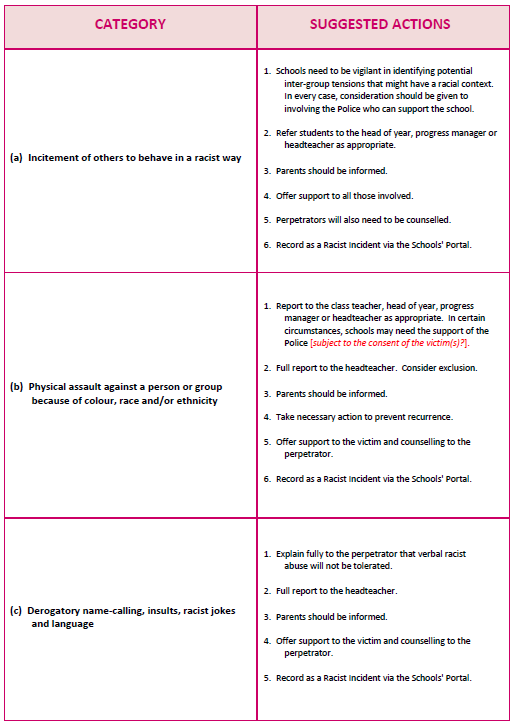
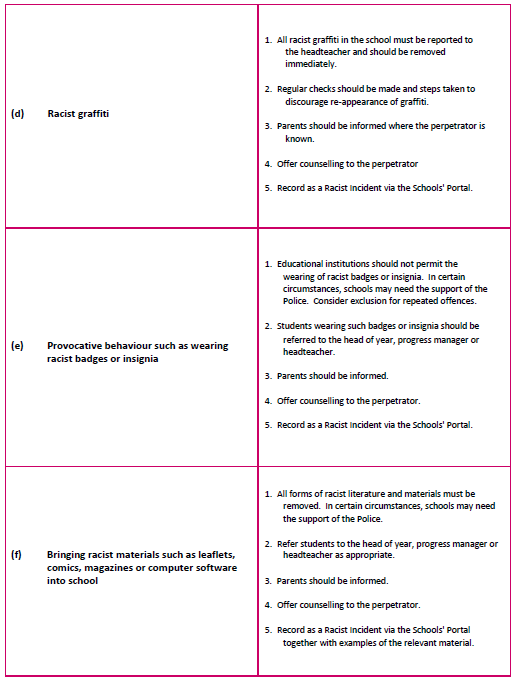
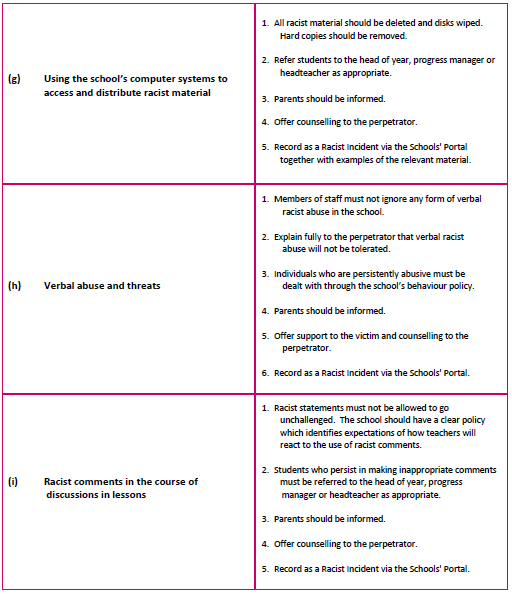
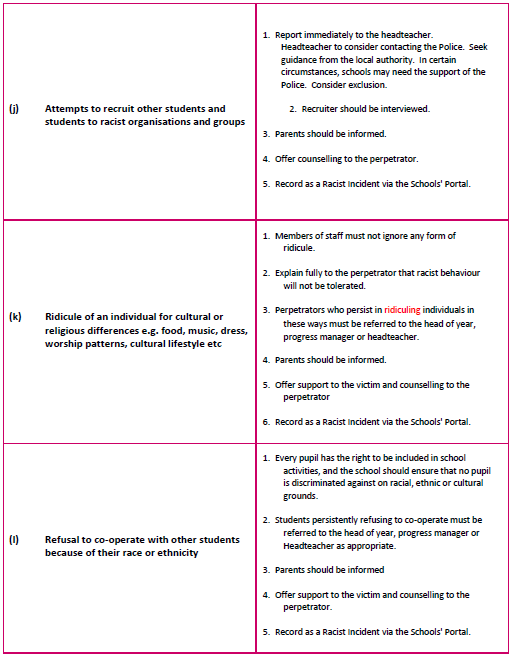
INCIDENTS INVOLVING STUDENTS
Schools may feel it appropriate to develop a checklist as part of their policy to ensure internal consistency in the use of sanctions in relation to incidents involving students. It is recognised that teachers will use their professional judgement in dealing with specific incidents, but individual practice should be based on school policy.
INCIDENTS INVOLVING STAFF
An allegation of racist behaviour on the part of any member of staff is a potentially serious disciplinary matter and it will be for the Headteacher/governing body to deal with. In addition there is a specific procedure that an employee can use for raising a complaint of racial harassment against a colleague, known as the model policy statement for the prevention of workplace and work-related harassment and bullying.
Where the victim of alleged racist behaviour by a member of staff is a pupil, the headteacher should, after careful investigation, consider what action to take. The Headteacher may seek to resolve the matter informally. If the matter cannot be resolved satisfactorily at this stage then the parents/carers and/or representative should submit the complaint in writing under the Schools’ Complaints Procedure to the Headteacher who will further investigate the case and take appropriate action. This could involve the use of formal disciplinary procedures.
Where a member of staff is the victim of racist behaviour by students, it is important that full support is given to the member of staff concerned. Guidance can also be sought from the school’s Principal HR Manager. Staff may also wish to seek support from their trade union/professional association.
INCIDENTS OUTSIDE OF SCHOOL
There may well be occasions when racist incidents outside school, or involving outside perpetrators, are brought to the attention of the headteacher. These incidents should be reported to the appropriate authorities. Opportunity should also be taken to condemn such incidents publicly.
Students may be subject to racist bullying and harassment on their journeys to and from school. Headteachers, governors and staff will be aware that the actions of students outside the school affect the reputation of the school. Schools have the right to discipline students for their behaviour outside the school gates where the students are in the charge of staff or it is reasonable for the school to regulate the students’ conduct; this rule of law has been clarified and put on a statutory basis by section 90(2)(a) of the Education and Inspection Act 2006.
Schools should encourage students to report such incidents to school staff, and these should be followed up, recorded and reported in the normal way. Following consultation with the victim and/or their parents, schools may report the incidents to the police, e.g., to the Youth Involvement Officer. Alternatively, they may work with local multi-agency partners to deal with incidents and prevent them recurring. Schools should also be aware that their students can commit racist acts against, for example, students from other schools, members of the public or against property, on their way to and from school. Schools should record and report these incidents. However, schools should also be aware that the victims of these incidents may prefer to report them directly to the police, who may contact the school for assistance in identification or to provide information. Schools should obtain advice from the County Secretary & Solicitor's Group as to the circumstances in which it will be permissible to share information with the police.
PROCEDURES FOR RECORDING RACIST INCIDENTS
It is recommended that all schools record racist incidents using the Schools' Portal when reporting to the local authority, along with a record kept in school.
Policies and procedures should be in place within each school to ensure that:
- preventative action is taken to reduce the likelihood of racist incidents occurring;
- racist behaviour is clearly identified as such;
- the victims of racist incidents are supported;
- perpetrators are dealt with effectively;
- the wider implications of racist incidents for the school and local community are recognised;
- the frequency and nature of racist incidents are monitored within the school;
- there is full and regular reporting of racist incidents to the governing body;
- there is full and regular reporting of racist incidents to the local authority.
Enclosed is a separate flow diagram to support schools in dealing with and reporting racist incidents.
It is recommended that a report be made to the governing body annually in the autumn cycle of meetings.
To report a Racist Incident please submit the information via the Schools Portal. The e-form can be located by following these steps:
- Log on to the Schools' Portal
- Select the 'A to Z search' (column to the left of the homepage)
- Select 'R'
- Select 'Racist Incidents'
You will find a list of several documents along with the Racist Incident Report form and the nil return e-form.
MONITORING AND REPORTING
It is helpful if records are kept of racist incidents to enable the school and the LA to identify any patterns of behaviour whereby individuals or groups can be shown to be regular victims or perpetrators of racial harassment.
SCHOOL RECORDS
All incidents which are perceived to be racist should be recorded.
The monitoring of these records on a regular basis will also provide the school with a picture of the frequency and nature of racist incidents and give some indication as to how effective the school is in combating such behaviour. This internal record keeping system may be inspected by OFSTED under the current inspection arrangements.
Headteachers should inform governors of racist incidents, particularly where serious or persistent offences occur. However, it is important that information given to governors does not prejudice their ability to act impartially and appropriately in any subsequent disciplinary action, complaint or appeal.
LOCAL AUTHORITY MONITORING
The purpose of reporting to the local authority is to enable the County Council to collect information on the nature and extent of racist incidents in Lancashire schools. The local authority does not identify or record the names of individual victims or perpetrators. The information collected is analysed to help to identify areas of concern, and to contribute to multi-agency monitoring. It is important that the Racist Incident Report Form be completed as soon as possible after the incident has occurred.
In addition to the regular submission of Racist Incident Reports, headteachers and the chairs of the governing bodies of those schools where there have been no racist incidents are asked to complete a 'NIL Return' (via the Schools' Portal) at the end of each academic year.
The aggregated statistics will be published by the local authority on an annual basis.
PROCEDURE FOR DEALING WITH RACIST INCIDENTS;
FLOW DIAGRAM
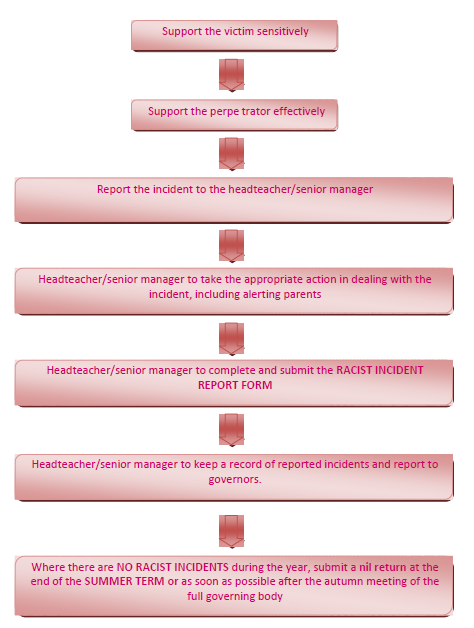
WHERE TO GO FOR SUPPORT
LANCASHIRE COUNTY COUNCIL
Mike Snelson
Principal Adviser
01772 533788
Joe Dykes
Senior Team Leader
Ethnic Minority/Gypsy, Roma and Traveller Achievement Service 01772 533788
Jane Richmond
Equality and Cohesion Teacher Advisor
01254 220793
David Croall
Senior Solicitor and Legal Adviser
to Schools
01772 530849
OTHER ORGANISATIONS
Commission for Race Equality and
Human Rights
Head Office
020 7939 0000
Teacher Support Network
08000 562 561
